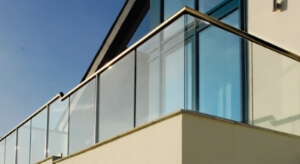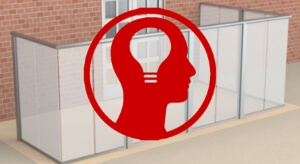Laminated Glass for Frameless Juliet Balconies is Heavy – How Will I Get It Upstairs?
Glass Balustrades | Juliet Balconies | Galleries | Articles | Case Studies
Quick options for more info for Juliet Balconies
BUY - Choose Type, Size, Colour
Our Frameless Juliet Balconies remain a firm favourite, and it isn’t hard to see why. These systems utilise a single glass panel to maximise your home by seamlessly connecting your upper floor living space with the outside, amplifying both space and fresh airflow. As the name suggests, Frameless Juliet Balconies do not need a supporting handrail, meaning that your panorama isn’t obstructed, and abundant daylight can flood into your home.
These aesthetic advantages are enabled by using the inherent strength of the 21.5mm laminated and toughened glass in combination with the slim but robust side profiles. The laminated glass consists of bonding two toughened 10mm glass panels together with a membrane layer that results in a sturdier and heavier glass panel. On average, this type of glass weighs 55kg per m2, and as expected, the weight of the glass panel increases with width, which can generate some challenges when manoeuvring and installing.
Stunning Frameless Juliet Balcony in a converted loft
What planning do I need to complete before lifting the laminated glass?
First things first, you will need to request the weight of the glass from our technical team (this is usually found in your signed technical drawings), and only when you have the confirmed weight and size of the system you can prepare and plan for the lifting of the glass. Alternatively, you can also calculate the weight of the glass yourself: width (m) X height (m) X 55kg = weight of glass panel (kg).
Regarding loads held close to the body, Manual Handling Regulations suggest that the maximum weight an individual can safely lift ranges from 20-25kg. Using these guidelines, it is recommended that four reasonably fit and well-trained individuals – two positioned at the front and two at the back - carry panels up to 100kg. For panels weighing 150kg or more, it is recommended that six people carry this load – two positioned at the front, two in the middle and two at the back. For Juliet’s that measure 1500mm and above, you may benefit from using lifting equipment (forklift, crane) or specific glass lifting equipment (Winlet or something similar) that can be used on-site to move the glass into position safely. Despite these recommendations, it is your responsibility as the customer to determine the appropriate method of lifting.
Always check the weight of your glass and always follow manual handling guidelines when lifting
Working at height is hazardous, and a risk assessment and method statement will need to be conducted before installation. There are several things you should consider ahead of fitting the glass:
- Plan your route to install – it is best to minimise the distance travelled with the glass and remove any obstacles en route to the opening.
- Check the weather – you do not want to be lifting and installing glass in windy or torrential rain conditions, so ensure you check the forecast in advance.
- Check the surface – it is vital to have level ground when erecting scaffolding or operating a forklift, crane, Winlet or similar glass lifting equipment to reduce the risk of injury.
- Consider fitting the side profiles ahead of the glass – you’ll already have enough to worry about on the day of manoeuvring the glass, so why not consider installing your side profiles beforehand to minimise the need to coordinate these two elements.
How will I lift this heavy panel of glass?
Below we share some of the methods previous customers and their installation teams have used to transport their pieces of laminated glass to the first-floor level. We must reiterate that the final decision on how you lift your glass lies with you and your building team, and these methods are simply suggestions to be used for guidance.
1. Manual Labour + Scaffolding
If you have an adequate amount of personnel available to lift the Frameless glass, you may be able to manually carry the single panel of glass through the house and up the stairs to meet the opening where the Juliet will be framed. Handheld suction cups or heavy-duty webbed straps can be used to move the glass; it is essential to secure the glass before moving and always keep the panel close to your body.
A wide fixed scaffolding platform can be erected outside the opening where the glass can be pivoted through and rested upon the platform before being manually lifted and connected to the pre-installed side profiles outside the building. It is essential to ensure that the scaffolding load can take the weight of the glass in addition to the individuals handling and fitting the glass.
This suggestion can help to keep costs down without the need of hiring lifting machinery. Yet, this option is unquestionably dependent on the size of the property you intend to move the glass through and whether you have enough personnel to lift the panel. Ensure ample space for turning and resting the glass throughout the route; otherwise, it would be prudent to consider an alternative method.
Wide fixed scaffolding erected outside of first-floor opening.
2. Forklift or Crane + Wide Scaffold with Loading Bay
A standard approach would be to combine the power of a forklift or crane, manual labour, and fixed scaffolding, which has an overhead gate, named a loading bay gate scaffold.
It is recommended that a loading bay gate scaffold is constructed alongside the opening where the Juliet will be affixed. A loading bay gate styled scaffolding is an apparatus that provides access to a raised loading platform by opening and closing a metal gate which simultaneously allows large, heavy products to be easily loaded at height by machinery. Once closed, it also creates a secure barrier that minimises the risk of working near an exposed edge.
Forklifts can be a useful tool for manoeuvring heavy glass
Once the Frameless Juliet flat-packed pallet has arrived, it can be elevated by a forklift or crane and loaded onto the platform before closing the gate. A team of installers can unpackage the glass panel and then manually carry the panel the length of the platform towards the opening before connecting it to the pre-installed side profiles on the outside of the building. The number of personnel manoeuvring the glass should be adequate to the size and weight of the glass. It is essential to ensure that the scaffolding width exceeds the width of the glass, and the scaffolding load can take the weight of the glass in addition to the individuals handling the glass.
3. Winlet or Similar Glass Lifting Equipment
A safe and efficient approach would be using a Winlet or similar glass lifting equipment. A Winlet is purpose-made glass handling equipment that combines lifting capacity and aerial reach by utilising an extendable arm with suction cups that securely hold the glass.
A Winlet or a similar glass suction device usually has an extendable arm that can reach overhead and precisely settle the glass panel onto the pre-installed side profiles' glass stoppers without needing to be manually handled or rested on a platform. Ensure that there is a clear path without any obstructions to the opening where the Frameless Juliet will be fitted since the large glass lifting equipment will need an open clearing to get as close to the building as possible.









